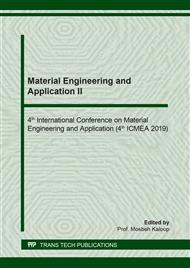[1]
B. Berman, 3-D printing: The new industrial revolution, Bus. Horiz. 55(2) (2012) 155-162.
Google Scholar
[2]
C. Weller, R. Kleer, F. T. Piller, Economic implications of 3D printing: Market structure models in light of additive manufacturing revisited, Int. J. Prod. Econ. 164 (2015) 43-56.
DOI: 10.1016/j.ijpe.2015.02.020
Google Scholar
[3]
R. Wimmer, B. Steyrer, J. Woess, T. Koddenberg, N. Mundigler, 3D Printing and Wood, ProLigno. 11 (2015) 144-149.
Google Scholar
[4]
T. Campbell, C. Williams, O. Ivanova, B. Garret, Could 3D Printing Change the World? Technologies, Potential, and Implications of Additive Manufacturing, Atl. Counc. Strateg. Foresight Rep. (2011).
Google Scholar
[5]
J. W. Stansbury, M. J. Idacavage, 3D printing with polymers: Challenges among expanding options and opportunities, Dent. Mater. 32(1) (2016) 54-64.
DOI: 10.1016/j.dental.2015.09.018
Google Scholar
[6]
M. P. Groover, Fundamentals of Modern Manufacturing: Materials, Processes, and Systems, Igarss 2014. (2014).
Google Scholar
[7]
F. Ning, W. Cong, J. Qiu, J. Wei, S. Wang, Additive manufacturing of carbon fiber reinforced thermoplastic composites using fused deposition modeling, Compos. Part B Eng. 80 (2015) 369-378.
DOI: 10.1016/j.compositesb.2015.06.013
Google Scholar
[8]
N. M. A. Isa, N. Sa'ude, M. Ibrahim, S. M. Hamid, K. Kamarudin, A Study on Melt Flow Index on Copper-ABS for Fused Deposition Modeling (FDM) Feedstock, Appl. Mech. Mater. 773-774 (2015) 8-12.
DOI: 10.4028/www.scientific.net/amm.773-774.8
Google Scholar
[9]
A. R. Torrado Perez, D. A. Roberson, R. B. Wicker, Fracture surface analysis of 3D-printed tensile specimens of novel ABS-based materials, J. Fail. Anal. Prev. 14(3) (2014) 343-353.
DOI: 10.1007/s11668-014-9803-9
Google Scholar
[10]
I. Anderson, Mechanical Properties of Specimens 3D Printed with Virgin and Recycled Polylactic Acid, 3D Print. Addit. Manuf. 4(2) (2017).
DOI: 10.1089/3dp.2016.0054
Google Scholar
[11]
B. M. Tymrak, M. Kreiger, J. M. Pearce, Mechanical properties of components fabricated with open-source 3-D printers under realistic environmental conditions, Mater. Des. 58 (2014) 242-246.
DOI: 10.1016/j.matdes.2014.02.038
Google Scholar
[12]
H. Jiang, D. P. Kamdem, Development of poly(vinyl chloride)/wood composites. A literature review, J. Vinyl Addit. Technol. 10(2) (2004) 59-69.
DOI: 10.1002/vnl.20009
Google Scholar
[13]
H. Valkenaers, F. Vogeler, E. Ferraris, A. Voet, J.-P. Kruth, A Novel Approach to Additive Manufacturing: Screw Extrusion 3D-Printing, in: Proc. 10th Int. Conf. Multi-Material Micro Manuf., (2013).
DOI: 10.3850/978-981-07-7247-5-359
Google Scholar
[14]
P. Data, A. Us, H. Ome, Properties of Polystyrene, Polym. Database. (2013).
Google Scholar
[15]
Z. Weng, J. Wang, T. Senthil, L. Wu, Mechanical and thermal properties of ABS/montmorillonite nanocomposites for fused deposition modeling 3D printing, Mater. Des. 102 (2016) 276-283.
DOI: 10.1016/j.matdes.2016.04.045
Google Scholar
[16]
S. Hwang, E. I. Reyes, K. sik Moon, R. C. Rumpf, N. S. Kim, Thermo-mechanical Characterization of Metal/Polymer Composite Filaments and Printing Parameter Study for Fused Deposition Modeling in the 3D Printing Process, J. Electron. Mater. 44(3) (2015) 771-777.
DOI: 10.1007/s11664-014-3425-6
Google Scholar
[17]
J. Hiller, H. Lipson, Design and analysis of digital materials for physical 3D voxel printing, Rapid Prototyp. J. 15(2) (2009) 137-149.
DOI: 10.1108/13552540910943441
Google Scholar
[18]
C. Yang, X. Tian, T. Liu, Y. Cao, D. Li, 3D printing for continuous fiber reinforced thermoplastic composites: Mechanism and performance, Rapid Prototyp. J. 23(1) (2017) 209-215.
DOI: 10.1108/rpj-08-2015-0098
Google Scholar
[19]
D. Rejeski, F. Zhao, Y. Huang, Research needs and recommendations on environmental implications of additive manufacturing, Addit. Manuf. 19 (2018) 21-28.
DOI: 10.1016/j.addma.2017.10.019
Google Scholar
[20]
T. D. Ngo, A. Kashani, G. Imbalzano, K. T. Q. Nguyen, D. Hui, Additive manufacturing (3D printing): A review of materials, methods, applications and challenges, Compos. Part B Eng. 143 (2018) 172-196.
DOI: 10.1016/j.compositesb.2018.02.012
Google Scholar
[21]
M. Kariz, M. Sernek, M. Obućina, M. K. Kuzman, Effect of wood content in FDM filament on properties of 3D printed parts, Mater. Today Commun. 14 (2018) 135-140.
DOI: 10.1016/j.mtcomm.2017.12.016
Google Scholar
[22]
U. Kalsoom, P. N. Nesterenko, B. Paull, Recent developments in 3D printable composite materials, RSC Adv. 6(65) (2016) 60355-60371.
DOI: 10.1039/c6ra11334f
Google Scholar
[23]
T. A. Campbell, O. S. Ivanova, 3D printing of multifunctional nanocomposites, Nano Today. 8(2) (2013) 119-120.
DOI: 10.1016/j.nantod.2012.12.002
Google Scholar
[24]
A. A. Klyosov, Wood-Plastic Composites, John Wiley & Sons, (2007).
Google Scholar
[25]
R. Malkapuram, V. Kumar, Y. Singh Negi, Recent development in natural fiber reinforced polypropylene composites, J. Reinf. Plast. Compos. 28(10) (2009) 1169-1189.
DOI: 10.1177/0731684407087759
Google Scholar
[26]
B. Tisserat, Z. Liu, V. Finkenstadt, B. Lewandowski, S. Ott, L. Reifschneider, 3D printing biocomposites, SPE Plast. Res. Online. (2015).
Google Scholar
[27]
R. H. White, M. A. Dietenberger, Wood Products: Thermal Degradation and Fire, Encycl. Mater. Sci. Technol. (2004) 9712-9716.
DOI: 10.1016/b0-08-043152-6/01763-0
Google Scholar
[28]
A. N. Shebani, A. J. van Reenen, M. Meincken, The effect of wood extractives on the thermal stability of different wood-LLDPE composites, Thermochim. Acta. 481 (1-2) (2009) 52-56.
DOI: 10.1016/j.tca.2008.10.008
Google Scholar
[29]
Y. Tao, H. Wang, Z. Li, P. Li, S. Q. Shi, Development and application ofwood flour-filled polylactic acid composite filament for 3d printing, Materials (Basel). 10(4) (2017).
DOI: 10.3390/ma10040339
Google Scholar
[30]
W. Zhong, F. Li, Z. Zhang, L. Song, Z. Li, Short fiber reinforced composites for fused deposition modeling, Mater. Sci. Eng. A. 301(2) (2001) 125-130.
DOI: 10.1016/s0921-5093(00)01810-4
Google Scholar
[31]
H. L. Tekinalp, V. Kunc, G. M. Velez-Garcia, C. E. Duty, L. J. Love, A. K. Naskar, C. A. Blue, S. Ozcan, Highly oriented carbon fiber-polymer composites via additive manufacturing, Compos. Sci. Technol. 105 (2014) 144-150.
DOI: 10.1016/j.compscitech.2014.10.009
Google Scholar
[32]
J. R. C. Dizon, A. H. Espera, Q. Chen, R. C. Advincula, Mechanical characterization of 3D-printed polymers, Addit. Manuf. 20 (2018) 44-67.
DOI: 10.1016/j.addma.2017.12.002
Google Scholar
[33]
X. G. Zhao, K. J. Hwang, D. Lee, T. Kim, N. Kim, Enhanced mechanical properties of self-polymerized polydopamine-coated recycled PLA filament used in 3D printing, Appl. Surf. Sci. 441 (2018) 381-387.
DOI: 10.1016/j.apsusc.2018.01.257
Google Scholar


